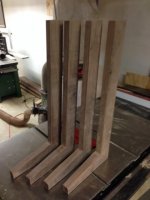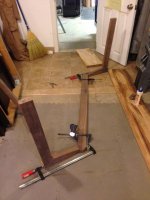s1nglemalt
Member
- Joined
- Aug 14, 2014
- Messages
- 14
I want to use the Domino XL to create the three angles required for a dining table 36" x 84" in walnut as similar to below.
a. The base angle will show the ~5' bottom base stretcher to the two side rails which will attach to it at the ends
b. The side rail angles will attach to the vertical pieces that will be angled ~10 degrees outwards
c. The vertical pieces will have a stretcher attached so I can attach the table base to the stretcher to allow for seasonality
My initial thoughts, subject to all suggestions, are to build the bottom base and side rails at 6/4 x 2" wide, and the vertical pieces at 6/4 x 3" wide. I would domino the side rails to stretcher at an angle of ~20 degrees without a mortise, just maximum surface area for each piece. For the verticals to the rails, I want max strength, so mortise or whatever you think.
I do not want to overthink this, but I do want to account for max strength so if someone sits on the table, the verticals will not give way. This is where "C" comes in with the tabletop stretcher doing more than just allowing for seasonality. There are a few ways to do this, and I know you can help a new Domino guy out. Danke.
a. The base angle will show the ~5' bottom base stretcher to the two side rails which will attach to it at the ends
b. The side rail angles will attach to the vertical pieces that will be angled ~10 degrees outwards
c. The vertical pieces will have a stretcher attached so I can attach the table base to the stretcher to allow for seasonality
My initial thoughts, subject to all suggestions, are to build the bottom base and side rails at 6/4 x 2" wide, and the vertical pieces at 6/4 x 3" wide. I would domino the side rails to stretcher at an angle of ~20 degrees without a mortise, just maximum surface area for each piece. For the verticals to the rails, I want max strength, so mortise or whatever you think.
I do not want to overthink this, but I do want to account for max strength so if someone sits on the table, the verticals will not give way. This is where "C" comes in with the tabletop stretcher doing more than just allowing for seasonality. There are a few ways to do this, and I know you can help a new Domino guy out. Danke.



